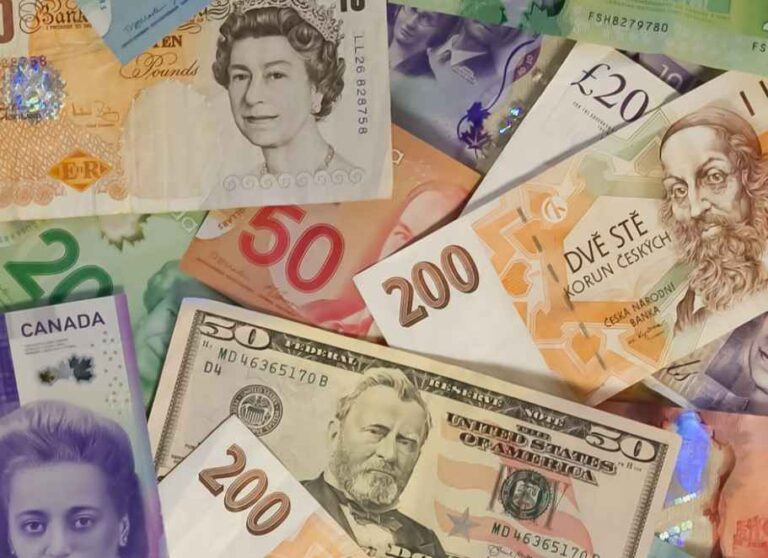Forex is one of the largest financial markets in the world and the average volume of currencies converted every day is over $5.1 trillion per day. In this article we will discover which are the 10 most important currencies, which represent approximately 90% of trading operations.
This ranking is based on the latest research conducted by the Bank of International Settlements, which measures turnover in the currency markets every three years.
Table of Contents
United States Dollar (USD)
Issued by the Federal Reserve (Fed), the US dollar is the official currency of the United States. It is the most traded globally with a daily trading volume of $2.2 trillion.
The reasons for its popularity are various. First of all, because the United States is the world’s largest economy and one of the main international trading powers. The second reason, because the US dollar is the main reserve currency in the world, held by central and commercial banks and is used in international transactions and investments.
The volume is estimated to constitute nearly 63% of foreign exchange reserves.2 The third is because many commodities, including gold, oil and copper, are valued in dollars.
Euro (EUR)
The euro is the official currency of the European Union (EU), as well as the second most traded currency globally, with a daily trading volume of almost $800 million. It is issued by the European Central Bank (ECB).
The popularity of the euro is due to the size and economic importance of the currency’s trading area: the eurozone, which currently includes 19 of the 28 countries that are part of the EU.
Japanese Yen (JPY)
The Japanese yen is the official currency of Japan and the third most traded currency globally, with a daily trading volume of almost 550 million dollars. It is also the third largest reserve currency. According to statistics it constitutes 4.9 % of global currency reserves. It is issued by the Bank of Japan (BoJ).
The value of the yen is strongly linked to the economic power of Japan, developed thanks to its strong industrial sector, which exports cars, hi-tech equipment, tools for industrial machinery, ships and textile products all over the world.
British Pound (GBP)
The British pound is the official currency of the United Kingdom, the fourth most traded currency globally, with a daily trading volume of almost $325 million. It is also the fourth largest reserve currency, with volume accounting for 4, 5% of global currency reserves.
In recent years its value has also been influenced by changes in relations between the United Kingdom and Europe: the country voted in favor of leaving the EU in the referendum of 23 June 2016.
Read also: UK and Japan in recession: the economic data from London and Tokyo
Australian Dollar (AUD)
The Australian dollar is the official currency of the Commonwealth of Australia, the fifth most traded currency globally, with a daily trading volume of $174 million. It is also the sixth largest reserve currency. Its volume constitutes the 1 .8% of global currency reserves. It is issued by the Reserve Bank of Australia (RBA).
The value of the Australian dollar is influenced by the price of raw materials and the terms of trade, which is the ratio between the prices of imports and exports.
Canadian Dollar (CAD)
The Canadian dollar is the official currency of Canada, the sixth most traded currency globally, with a daily trading volume of $130 million. It is also the fifth most commonly held reserve currency, making up 2.02% of global foreign exchange reserves by value. It is issued by the Bank of Canada (BoC).
Like Australia, Canada is a country rich in natural resources and one of the largest exporters of raw materials in the world. This means that the price of these commodities is one of the main factors, which determine the value of the Canadian dollar.
Swiss Franc (CHF)
The Swiss franc is the official currency of Switzerland, the seventh most traded currency globally with a daily trading volume of $122 million. It is also the eighth most commonly held reserve currency, accounting for 0.18% of global foreign exchange reserves by value. It is issued by the Swiss National Bank (SNB).
The country’s reputation for financial services and banking secrecy, sound monetary policies and low debt levels have made the Swiss franc a so-called “safe haven” currency.
Chinese Renminbi (CNH)
The Chinese Renminbi, informally known as “yuan”, is the official currency of the People’s Republic of China, the eighth most traded currency globally with a daily trading volume of $101 million.
Although it is the currency of a emerging market currency has become the seventh most held reserve currency in the world. It constitutes 1.23% of global reserves. It is issued by the People’s Bank of China (PBoC).
Swedish Krona (SEK)
The Swedish krona is the official currency of Sweden and the ninth most traded currency globally, with a daily trading volume of $56 million. Unlike most of the currencies on this list, the krona is not a major reserve currency. It is issued by Sveriges Riksbank, the Swedish central bank.
The value of the crown depends mainly on the monetary policies adopted by Sveriges Riksbank, but also on the economic performance of Sweden and its main trading partners: European countries, Norway and the USA.
New Zealand Dollar (NZD)
The New Zealand dollar is the official currency of New Zealand and the tenth most traded currency globally, with a daily trading volume of $52 million. Just like the krona, it is not among the major reserve currencies. It is issued by the Reserve Bank of New Zealand.
The value of the New Zealand dollar is closely linked to New Zealand’s trade relationships, the value of the country’s imports and exports, as well as the strength of trading partners’ currencies. New Zealand’s main trading partners are China and Australia.












